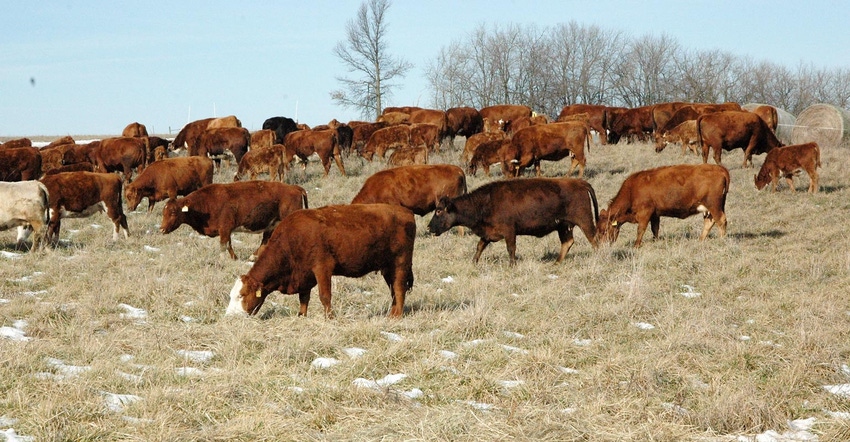August 26, 2020

Now is the prime time to take cattle off fescue pasture and stockpile it for winter grazing, says Craig Roberts, University of Missouri Extension forage specialist. The practice helps cattle producers save time and money by reducing the need to feed hay.
Fescue, the top forage in Missouri, remains popular because of its persistence, resistance to insects and disease, and long growing season, Roberts says. Its waxy cuticle keeps its leaves green while growth slows after mid-October, making it the most suitable forage for stockpiling.
However, fescue contains ergovaline, a toxic alkaloid that reduces the health and profitability of cow herds. Losses come from low gains, lost conceptions and heat stress. The toxic alkaloids, produced by an endophyte fungus, constrict blood flow to legs, ears and tails. Fescue foot in winter leads to death. In summer, cattle cannot cool properly.
Therefore, producers must manage fescue differently than other grasses, Roberts says. It starts by removing cows from fescue pastures by mid-August. Then he recommends fertilizing the pastures with low rates of nitrogen. Let the pasture grow. Begin grazing when hay and pasture run out in late winter when fescue is least toxic.
Toxins peak in spring and fall
Research from several universities shows that tall fescue is as toxic in fall as it is in spring, Roberts says. In Missouri, ergovaline concentrations peak in June and then spike again in October and November.
Stockpiling takes advantage of fescue growth cycles. Fescue, a cool-season grass, has two growing seasons. Most productive growth comes in the spring, then fescue goes into a low-growth summer slump. When fall rains return, grass grows again. Then fescue becomes toxic again.
Fall toxins are more difficult to regulate than spring toxins, Roberts says.
“If you want healthy animal production, you must manage alkaloids,” he says. “Health and production problems occur because of these two peaks.”
Proper management of tall fescue, which differs from other types of fescue, is critical to herd health and profits.
The only silver bullet for fescue toxicosis is a novel-endophyte tall fescue. But many people continue growing Kentucky 31 fescue. Roberts advises producers to manage with “incremental alleviation.” In other words, use multiple practices at the same time.
A single practice may provide partial relief, but it will not be enough to prevent health problems in animals. “You must do all at the same time to achieve acceptable performance,” Roberts says.
Practices to lessen toxins
Roberts lists eight common practices to reduce toxins:
1. Dilute pastures. Interseed fescue pastures with legumes such as annual lespedeza, red clover and white clover.
2. Supplement diet. Add corn or other feeds to reduce toxin levels. Corn gluten and other byproduct feeds are common supplements.
3. Rotate to summer. Remove cows from pastures from mid-May to early fall.
4. Limit nitrogen. Nitrogen boosts forage yields, but it also feeds the fungus, causing more toxins. Toxin levels and nitrogen needs vary year to year, making it difficult to know how much to apply, Roberts says. Research also shows that nitrogen reduces clover, a legume that can dilute toxins. Applying as little as 35 pounds per acre increases toxins. Studies show that nitrogen applied at 60 pounds per acre significantly raised toxin levels.
5. Clip seedheads. Toxins are hottest in seedheads. They also are heavy in the lowest 2 inches of vegetative leaves and stems, according to research by Sarah Kenyon, MU Extension field agronomist. In the fall, fescue grows only leaves, not seed stems. Leaves store the toxins.
6. Ammoniate hay. Treat low-quality baled hay with ammonia to reduce toxins, make it more digestible, and improve weight gains and milk production by up to 50%. Toxins in cut hay drop by a third within three weeks and by 50% after six months. Keep in mind that fescue made into silage maintains its toxicity.
7. Graze the stockpile late. Normally, cows graze stockpile first, then feed hay after. It is best to reverse this, Roberts says. Stockpile is far less toxic in February and March.
8. Spray. Using low rates of recommended herbicides will reduce seedheads in the spring. It makes the pasture less toxic.
Killing the old fescue and reseeding a new variety of novel-endophyte fescue can solve problems with toxic fescue, Roberts says.
New varieties cut losses and improve gains. Roberts and other forage experts across the Fescue Belt teach how to seed new varieties at schools offered by the Alliance for Grassland Renewal. For more information, visit grasslandrenewal.org.
Source: University of Missouri Extension, which is solely responsible for the information provided and is wholly owned by the source. Informa Business Media and all its subsidiaries are not responsible for any of the content contained in this information asset.
You May Also Like




